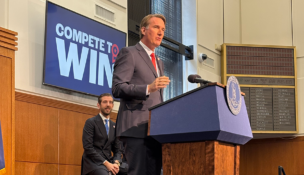JLARC: GO Virginia’s economic impact positive but undefined
Funded projects claim 10k jobs not directly created by grants

GO Virginia divides the state into nine regions. Image from a Joint Legislative Audit and Review Commission presentation.

GO Virginia divides the state into nine regions. Image from a Joint Legislative Audit and Review Commission presentation.
JLARC: GO Virginia’s economic impact positive but undefined
Funded projects claim 10k jobs not directly created by grants
The state’s GO Virginia economic development initiative is likely improving regional collaboration and having positive economic impacts, but those can’t be reliably determined, according to a Joint Legislative Audit and Review Commission report presented Monday.
In 2022, JLARC directed staff to review GO Virginia, which the state government created in 2016. GO Virginia provides economic and workforce development grants to encourage regional collaboration and grow and diversify local economies.
The state is divided into nine GO Virginia regions, each with its own governing council and growth and diversification plan. The councils and GO Virginia’s powerful statewide board make grant funding decisions, while the Department of Housing and Community Development administers the program.
“While GO Virginia’s ultimate goal is to strengthen the economy, it is not an incentive program or a job creation program,” said JLARC Chief Legislative Analyst Mark Gribbin, who led the review and presented the findings.
For fiscal years 2018 to 2023, Go Virginia awarded 226 grants totaling $110 million, with about 67% of those grants going to public organizations like local governments, colleges, universities and regional organizations. About 33% have gone to nonprofits. Grants cannot directly go to, benefit or attract specific businesses.
Grants fall into four categories:
- Workforce development, which accounted for 44% of grants and $49 million awarded;
- Site development, which accounted for 14% of grants and $23 million awarded;
- Startup ecosystem, which accounted for 22% of grants and $17 million awarded;
- And cluster scale-up, which accounted for 20% of grants and $22 million awarded.
GO Virginia appears to be improving regional collaboration through funded projects, regional councils with public and private stakeholders and regional growth plan development, JLARC found. Funded projects must include at least two local government partners, and all 133 Virginia localities have participated in a GO Virginia-backed project. In a JLARC survey of local economic development staff, 77% of respondents thought GO Virginia had improved regional collaboration.
GO Virginia projects have had positive impacts that might not have occurred without grants from the program, according to JLARC, and the majority of GO Virginia projects would probably have not moved forward without the program, or would have moved forward more slowly or on a smaller scale.
However, GO Virginia’s overall economic impact can’t be determined because project outcomes aren’t reliably reported, according to the report. Projects self-report outcomes, and some project teams claimed outcomes that were not directly caused by their projects.
Reasons for that are that some project leads were inexperienced in economic development or grant reporting, and regional council staff were not consistently verifying reported outcomes. Also, some metrics set by DHCD remain too broad to be helpful, like a “jobs created/filled” measure that merges the numbers of new jobs and existing jobs that were filled.
JLARC staff examined a sample of 54 projects and found that only about 10% of the jobs that GO Virginia-funded project teams claimed were created or filled by the projects could be directly attributed to those projects — 1,237 jobs out of the 12,771 jobs reported as project outcomes.
JLARC recommended that:
- DHCD revise its list of outcome metrics,
- the GO Virginia statewide board assign responsibility for verifying outcomes to DHCD,
- and the board should assess long-term impacts past the two-year grant period and determine which information to collect for those assessments.
The review also found that some GO Virginia eligibility and application requirements are unnecessarily restrictive, including the funding match requirements for eligibility. Under state law, GO Virginia initially required matches equal to the grant amount, and by board policy, the total match had to include a local match of $50,000, or 50% of the grant total – whichever was higher.
Following the COVID-19 pandemic, however, the GO Virginia board temporarily reduced match requirements to half of the total grant amount and dropped the local match requirement. As a result, more grants were awarded. From FY18 to FY20, only 92 grants were awarded, but under the reduced match requirements from FY21 to FY23, GO Virginia awarded 112 grants. The amounts granted also increased, from $20.6 million to $51 million, and the percent of available grant funds used rose from 47% to 97%.
Although the state has to put up a larger share of funding under the lower match requirements, $4.4 million more outside funding came in.
Additionally, JLARC found that GO Virginia’s administration structure is working, and the program is similar to other state programs but doesn’t duplicate them.
But, GO Virginia funds are going unused, and if changes to restrictive eligibility requirements aren’t made, then the program’s appropriations could be reduced. The program has only used $97 million of the $157 million appropriated to its grant programs from FY18 to FY23, according to JLARC. The General Assembly has recaptured $40 million in unobligated funds, and at the end of FY23, $27 million remained unobligated.
















